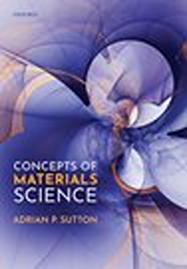Concepts of Materials Science
Material type: TextLanguage: English Publication details: Oxford : Oxford University Press, c2021Edition: 1stDescription: xi, 137 p. : illISBN:
TextLanguage: English Publication details: Oxford : Oxford University Press, c2021Edition: 1stDescription: xi, 137 p. : illISBN: - 9780192846440
- 620.11 SUT
| Item type | Current library | Collection | Shelving location | Call number | Copy number | Status | Date due | Barcode |
|---|---|---|---|---|---|---|---|---|
 Lending Collection
Lending Collection
|
Circulation Section | Department of Materials Engineering | Circulation Section | 620.11 SUT | 2023-24 | Available | 98581 |
AUTHOR
Adrian P. Sutton, FRS, Emeritus Professor, Faculty of Natural Sciences, Department of Physics, Imperial College London
Educated at the Universities of Oxford and Pennsylvania, Adrian Sutton has studied materials for 48 years, publishing 230 papers and five books. At Oxford University he taught across the undergraduate curriculum. His research is on theory and simulation of materials (TSM) and he is a founding member of the Thomas Young Centre, the London Centre for TSM. In 2009 he established the renowned Centre for Doctoral Training on TSM at Imperial College. In 2012 he was awarded the Rector's Medal for Outstanding Innovation in Teaching at Imperial College and in 2018 he became an Emeritus Professor in the Department of Physics at Imperial College. He is a Fellow of the Royal Society.
SUMMARY
All technologies depend on the availability of suitable materials. The progress of civilisation is often measured by the materials people have used, from the stone age to the silicon age. Engineers exploit the relationships between the structure, properties and manufacturing methods of a material to optimise their design and production for particular applications. Scientists seek to understand and predict those relationships.
This short book sets out fundamental concepts that underpin the science of materials and emphasizes their relevance to mainstream chemistry, physics and biology. These include the thermodynamic stability of materials in various environments, quantum behaviour governing all matter, and active matter. Others include defects as the agents of change in crystalline materials, materials at the nanoscale, the emergence of new science at increasing length scales in materials, and man-made materials with properties determined by their structure rather than their chemistry.
The book provides a unique insight into the essence of materials science at a level suitable for pre-university students and undergraduates of materials science. It will also be suitable for graduates in other subjects contemplating postgraduate study in materials science. Professional materials scientists will also find it stimulating and occasionally provocative.
